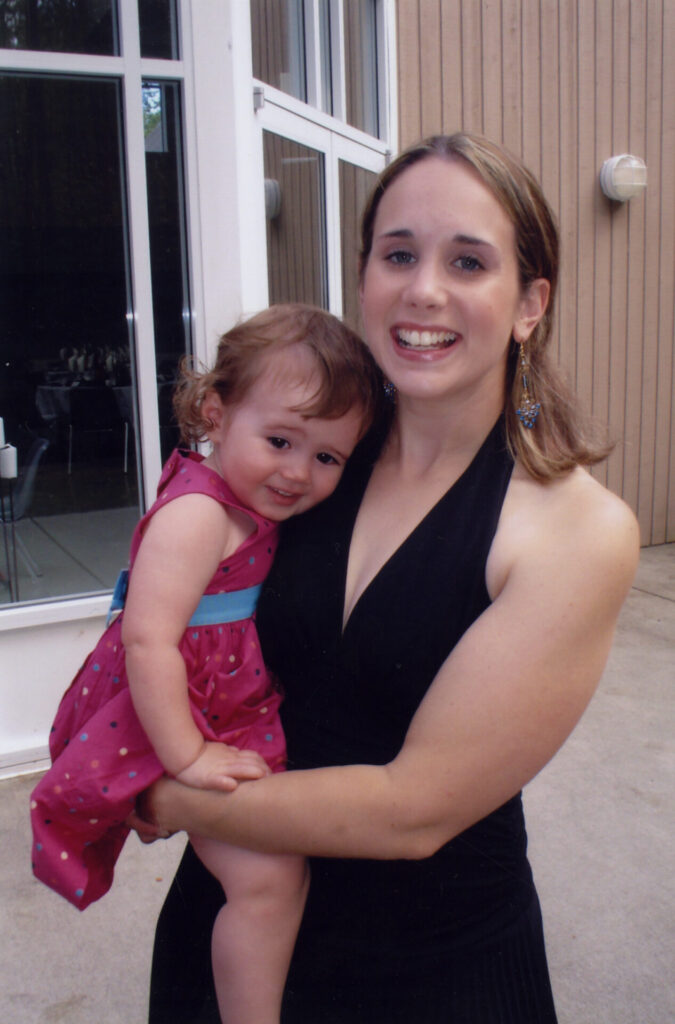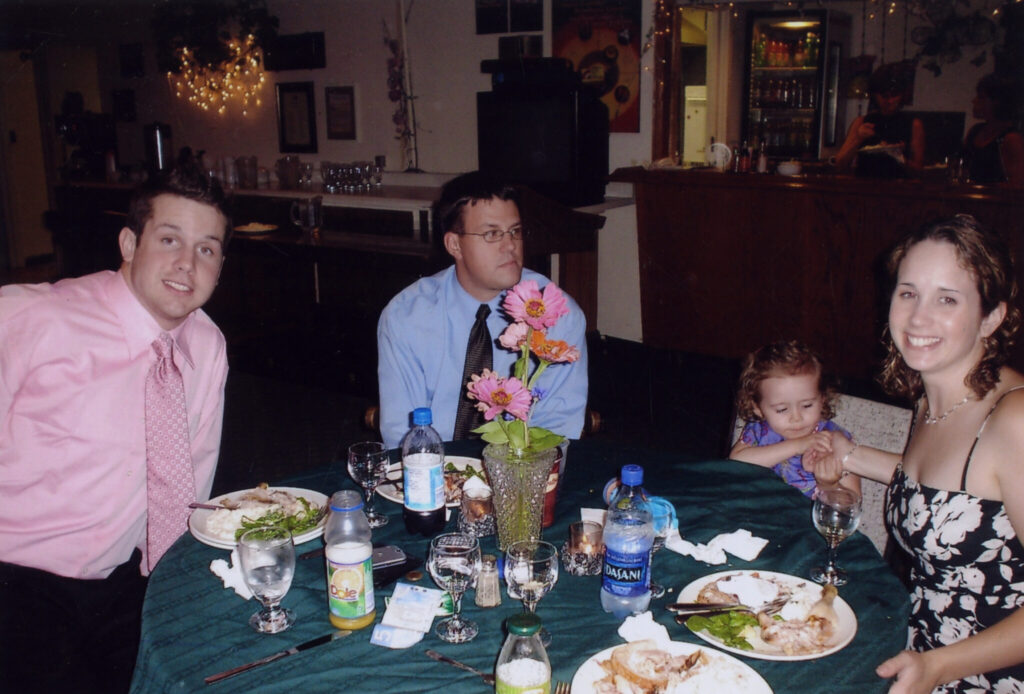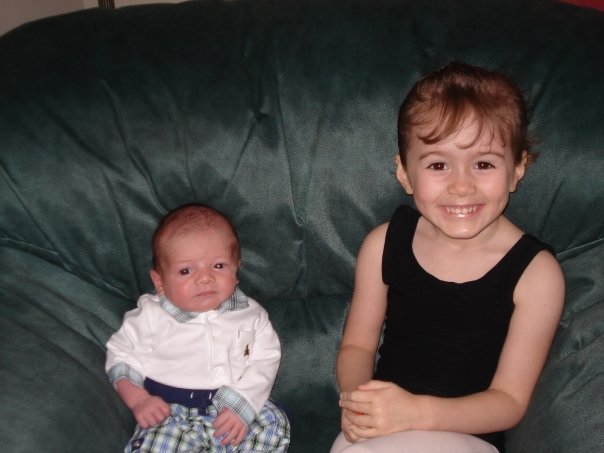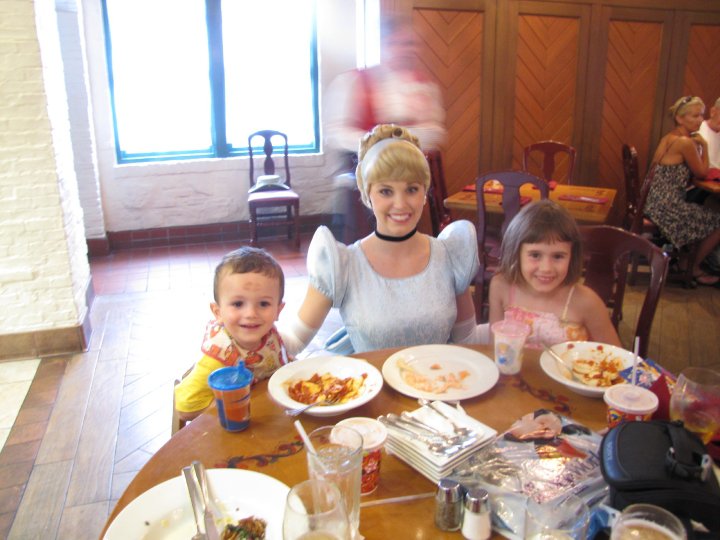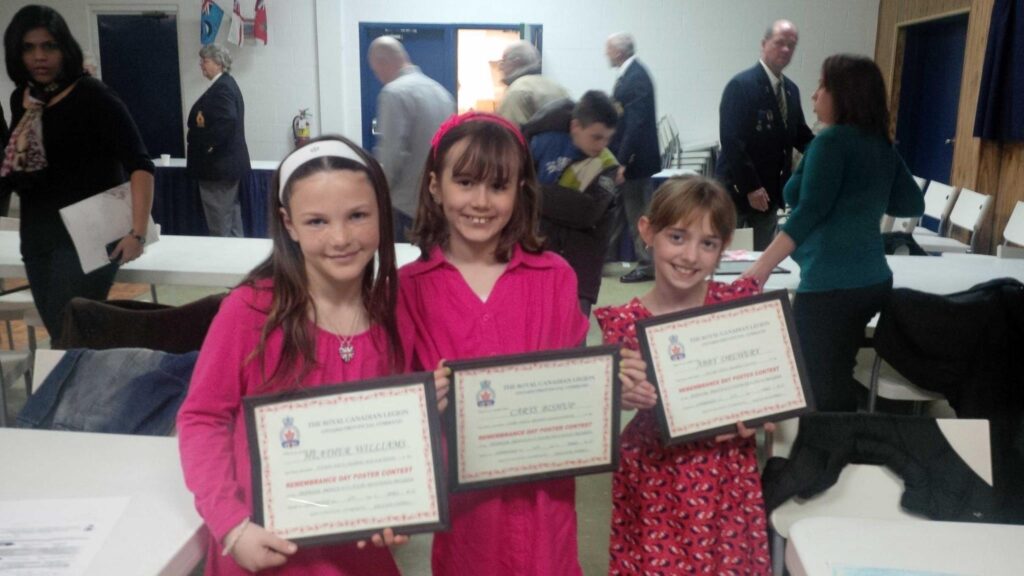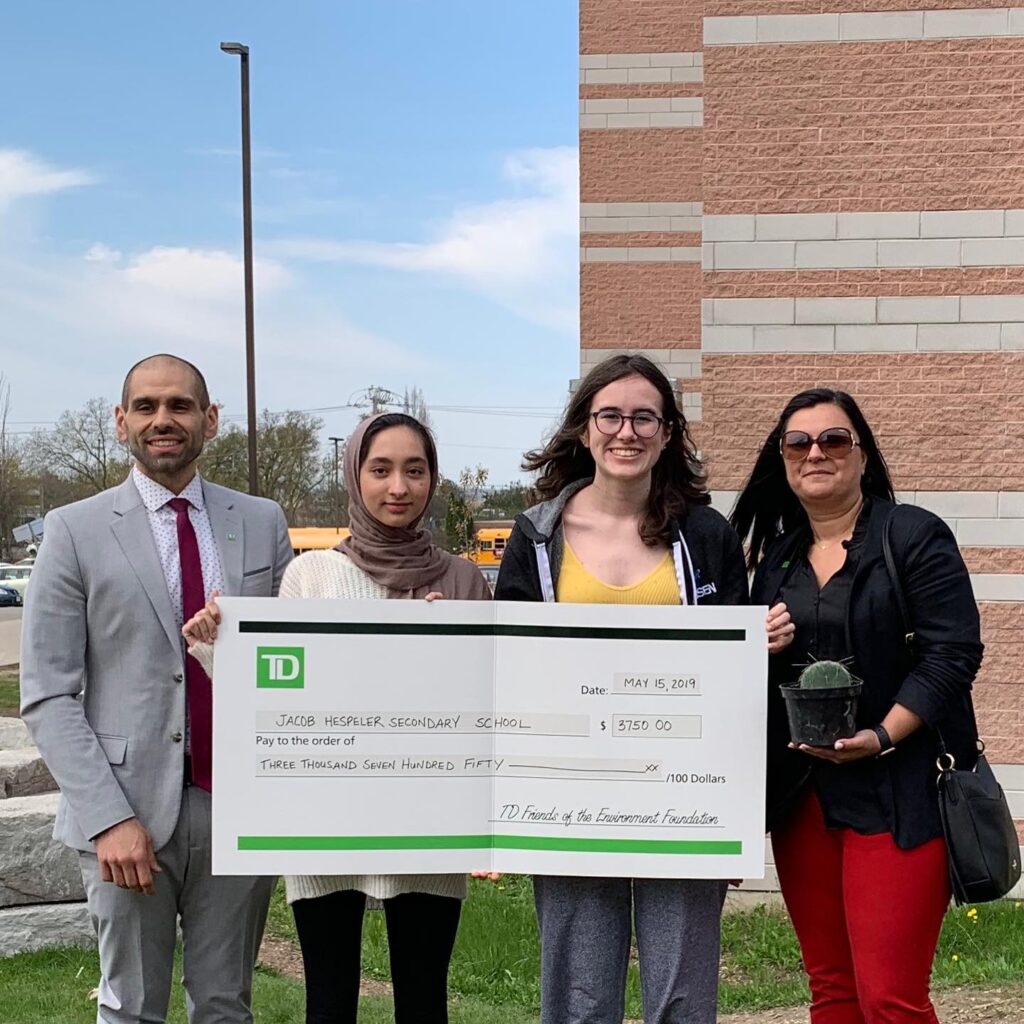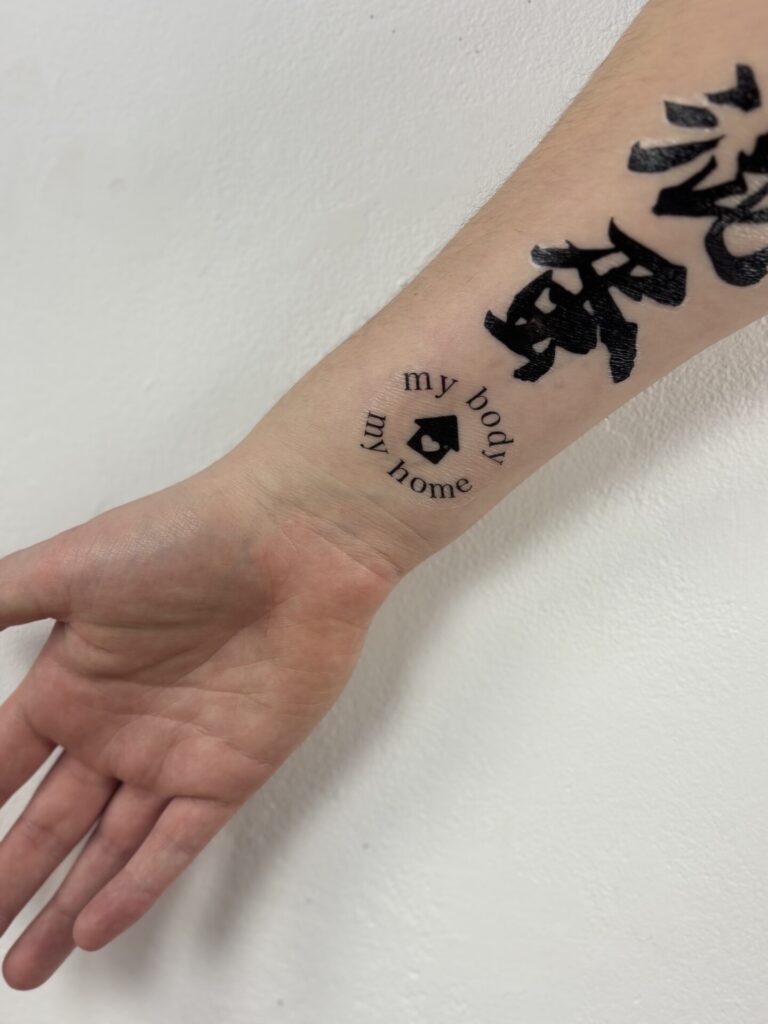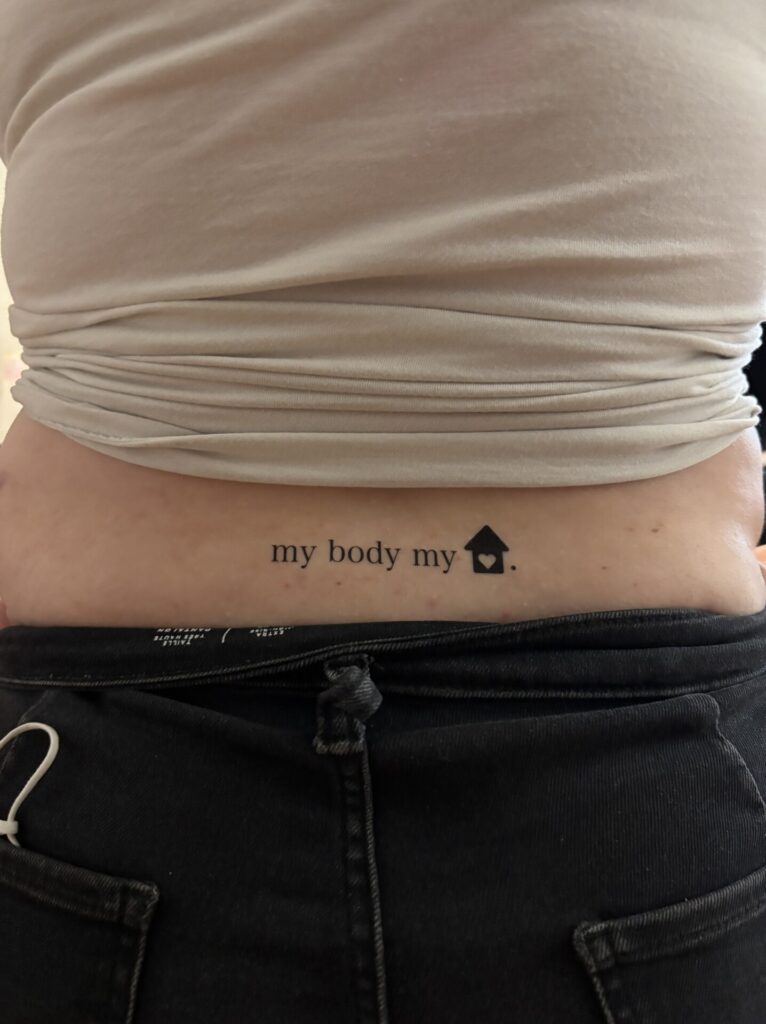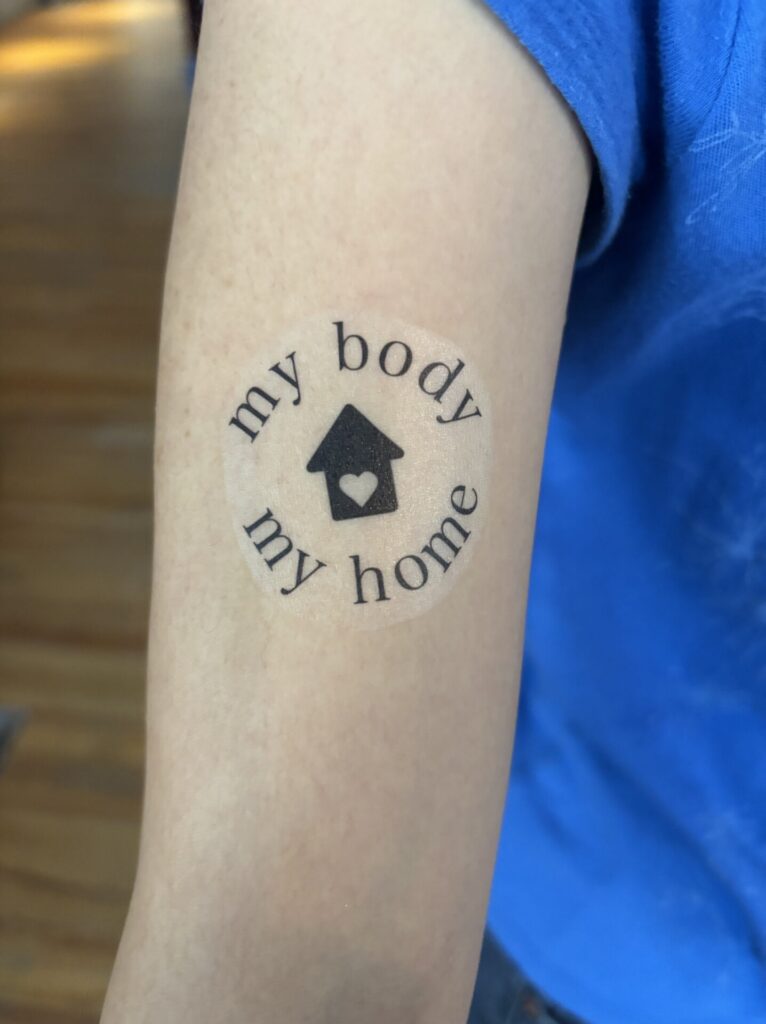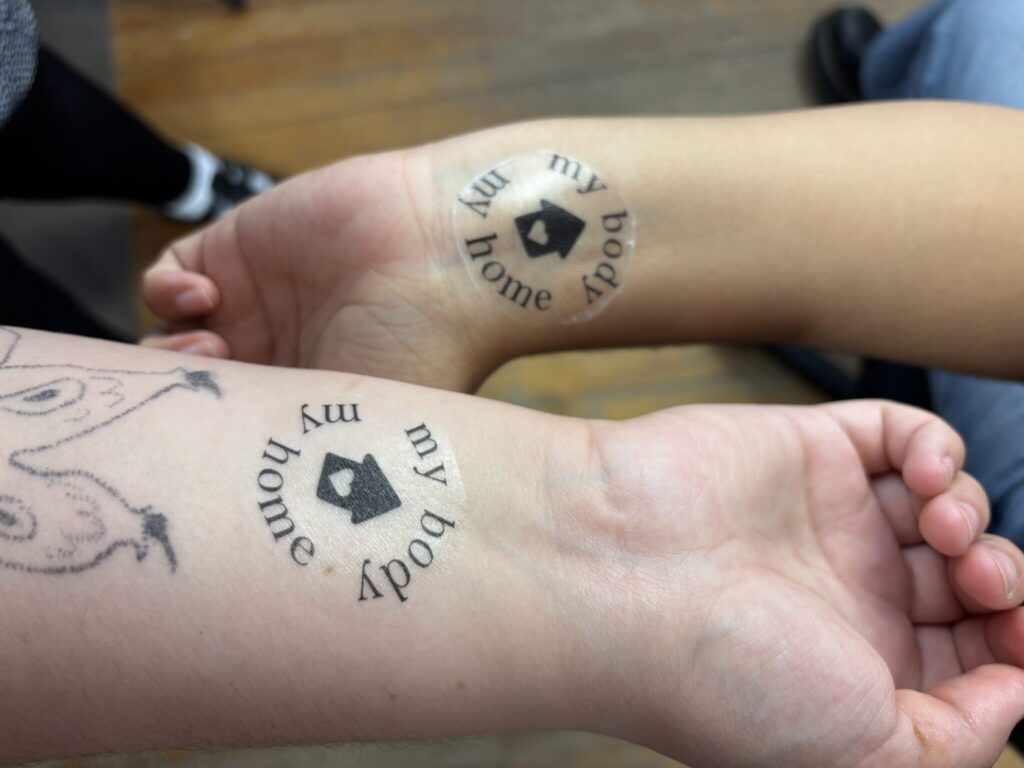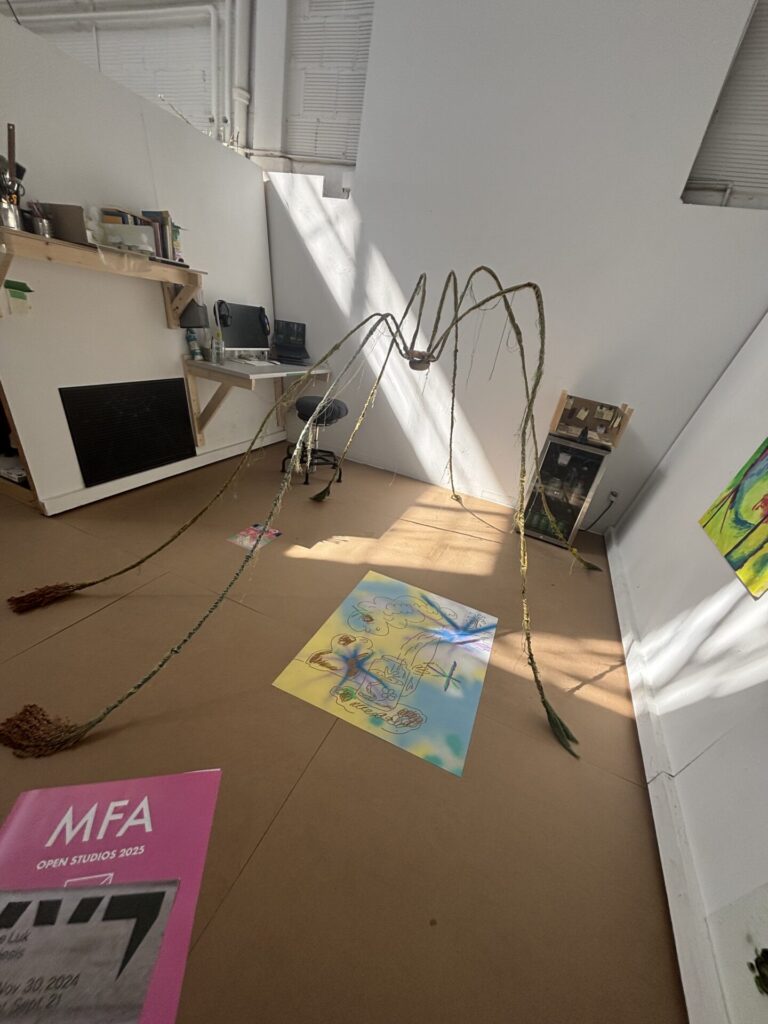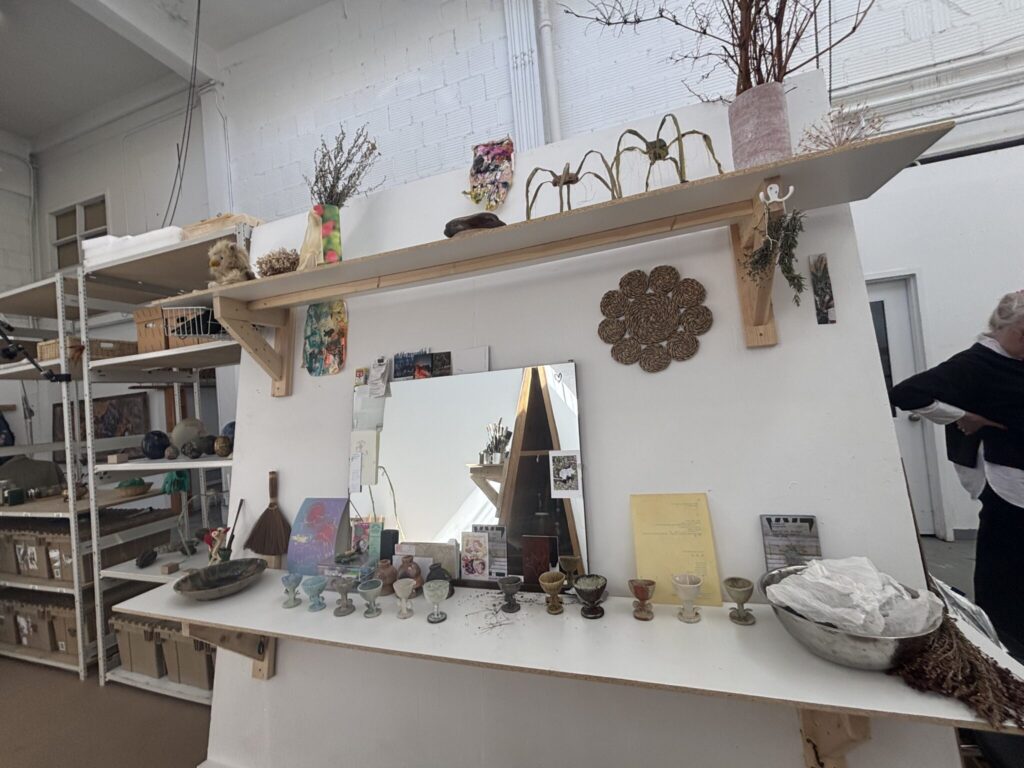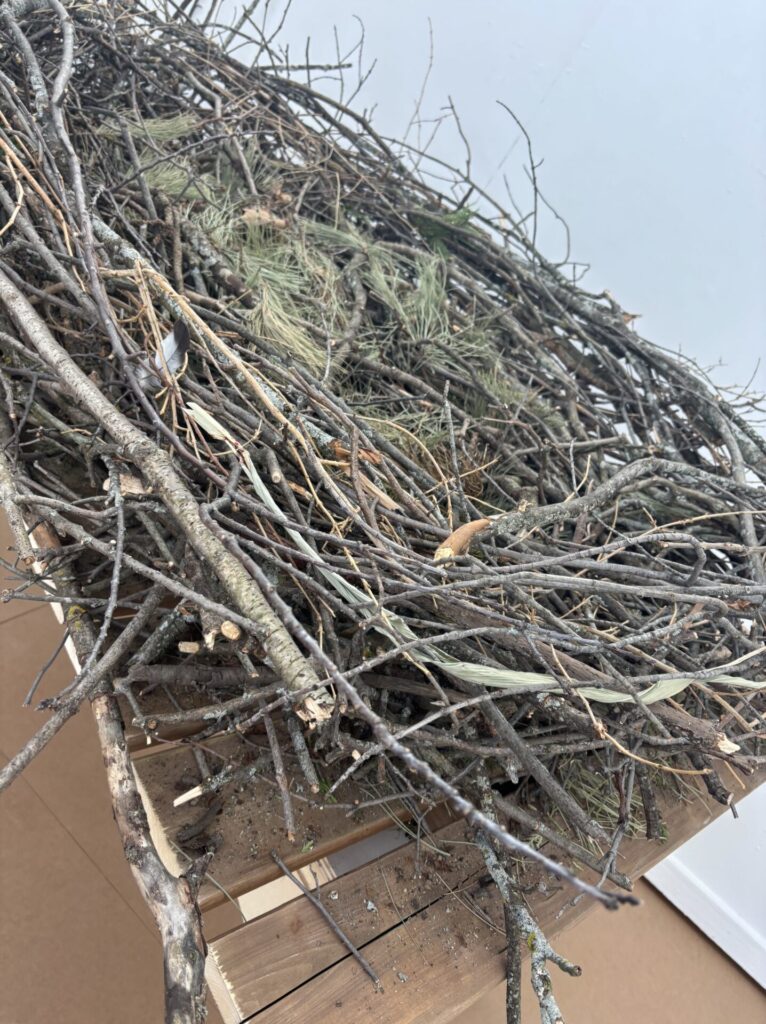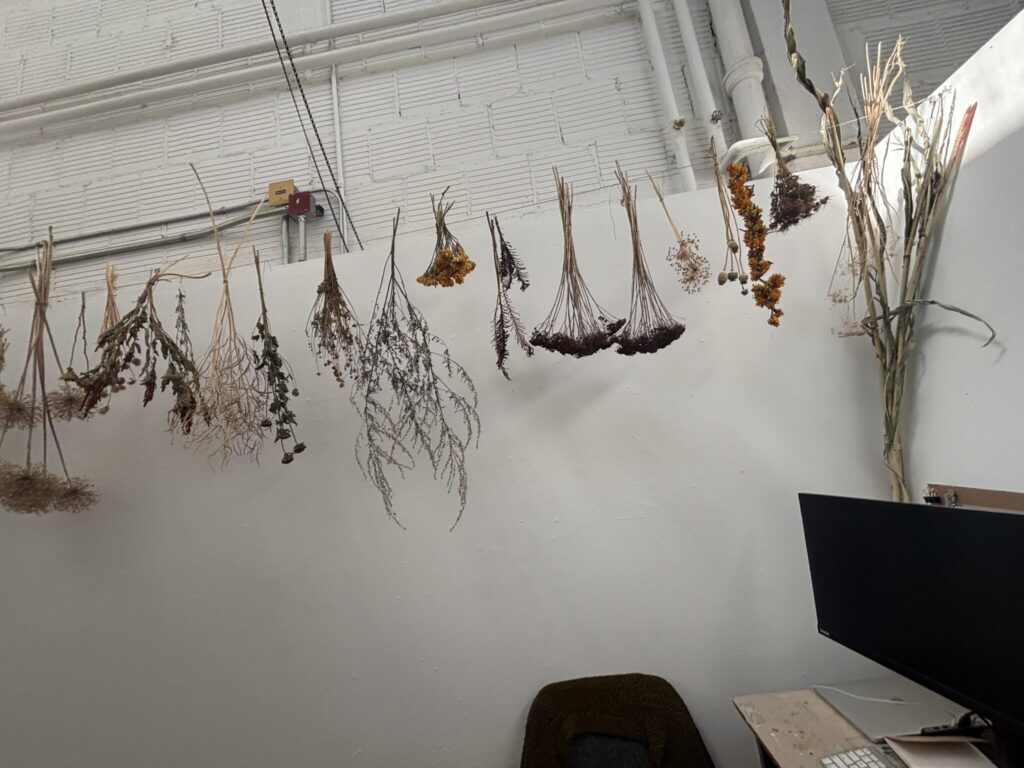You’ve stumbled upon my blog! Enjoy your stay 🙂
Banner Assignment
Possible Phrases:
- “depend on the feminist” – put on a pro-life ad, pro-life clinic, politically relevant and asks the viewers to depend on the feminist for women’s rights
- “praise and a kiss of death”
- “meditation on vulnerability and dissimulation”
- “safe and exposed positions” – a commentary on sexuality and intimate parts we share about ourselves
- “I am not bound to them” – talking about personal traumas, the location reflects that and gives the viewer an insight into my trauma. I am not bound to the individuals who have caused me trauma
- “conspicuous individuality” – put in front of a mirror, a comment on how we are all unique and have individualities that are recognizable to others but not to us – hence the mirror asking the individual to look at it and ponder their individualities and things that make them unique
Conspicuous Individuality, Carys Bishop, mixed media, 2025
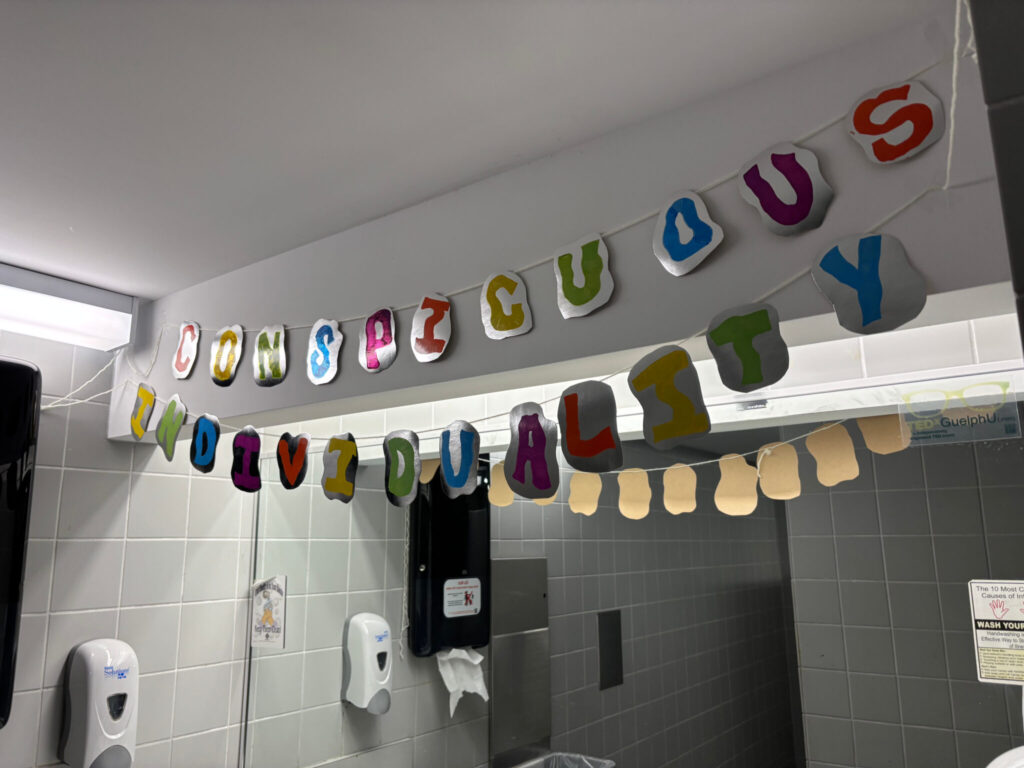
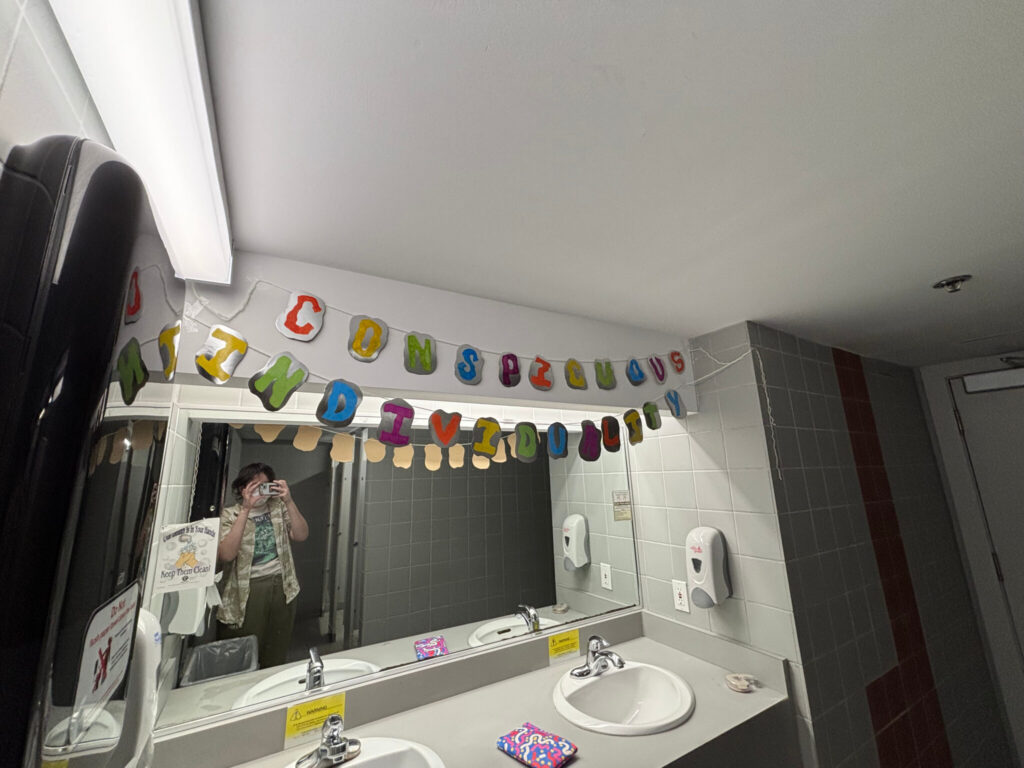
The phrase I chose from the reading Dirty Words: Tammer-El-Sheikh, from Canadian Art, was “Conspicuous Individuality.” This phrase stuck out to me because I enjoyed the sound of it, it wasn’t until I brainstormed a deeper meaning behind it that I selected it as my piece for my banner. The word conspicuous means something obvious or that stands out, so I wanted to look at features about ourselves that make us unique and individual. Nowadays I find we are so wrapped up with social media and comparing ourselves to the cookie-cutter ideal person society wants us to be. We may not notice unique features we possess that make us who we are or point them out as bad. The phrase “Conspicuous Individuality” combined with the placement of the banner, intends to get the reader to step back and think about the obvious and beautiful individualities that make them who they are. So long we spend in front of mirrors perfecting our appearance, but what if we just stood there noting all of the things that make us unique that we may not notice but others do? That’s exactly what I aim for the banner to beg of the viewer.
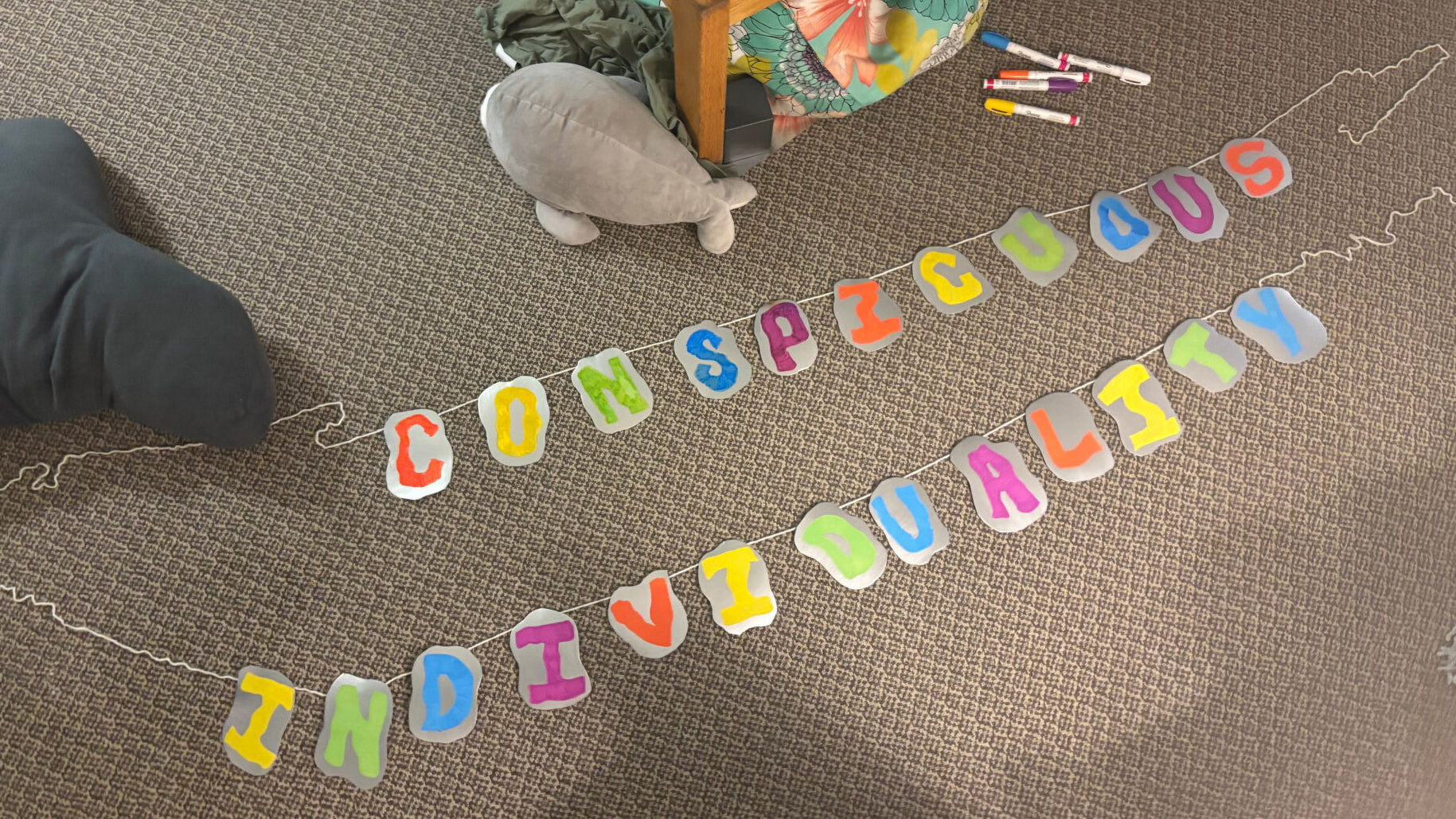
In making the banner, I cut unique shapes out of foil paper, ensuring each shape is different. As our individualities are unique, so are the shapes of paper. The choice of material was made to resemble a mirror, echoing the calling for looking at oneself. The warped and wavy shapes and fonts that make up the banner are intended to represent a warped sense of self, as many of us experience for numerous reasons, especially social media as I mentioned.
Neil Postman’s Amusing Ourselves to Death, 1985
Notes regarding the summarization of the material:
- Though certain elements of the book are outdated, many of its messages about the consumption of information through media such as television, political trends due to television, and the absorption of our minds into television allowing us to neglect things in our lives
- The world of television requires a level of complexity that previous forms of communication could not provide
- The accessibility of television has had arguably negative effects on our society, such as decreased attention spans, fragmented information, social isolation, less exercise in children, an overreliance on the media for information
- Language and how humans communicate are what frame our worldview
- Media directs how we see the world
- Society becomes overreliant on technical innovations such as the clock and now the television
- Language is our media, and through media are metaphors, and through the metaphors we create our cultural content
Quotes for discussion:
“As [Aldous Huxley] saw it, people will come to love their oppression, to adore the technologies that undo their capacities to think” (Foreword, Page xix)
- This prediction mentioned by Postman I don’t think has ever been more relevant. In an age where most of our media consumed is mostly short-form content, we are controlled by our phones, by our constant need to consume and scroll. Children spend less time outside, people are more isolated, conspiracy theories are rampant, and we consume fragmented information, all effects stemming from what Postman warned about, which is now more relevant than ever. With the rapid and consistent consumption of media, we are rarely questioning what we consume, how it affects us and how we think. In a way, it is making the consumer dumber, not allowing us to think critically about what we consume and allowing the television to just lead us in whatever direction. People are inclined to believe whatever they are told by the person behind a screen without any facts or sources to back it. With media as accessible as it is now, anyone can have a say on anything and may or may not be taken credibly. Despite seemingly making us as consumers dumber and media being the cause of a lot of our distress, we love it, we can’t get enough. These days, we have our media right at our fingertips, ready to consume at any time, continuously; we don’t care how it affects us, we’re addicted. This prediction mentioned in the foreword is not only a great lens to look at the book through, but also our modern society.
“Whether we are experiencing the world through the lens of speech or the printed word or the television camera, our media-metaphors classify the world for us, sequence it, frame it, enlarge it, reduce it, color it, argue a case for what the world is like.” (Page 10)
- This notion of the media we consume frames the way our world view is like is very prevalent in our modern day society. In a world of not only television but also the internet, the content we consume frames how we think about the world. Especially now, in the age of TikTok, we are seeing waves of political ideologies reach us in ways the TV never could – it all feels more personal on our handheld devices, as if they are talking to us. A good example of this phenomenon is the misogynistic right-wing content many young boys are consuming on TikTok and YouTube. It is through consuming that content that they learn how to engage with the world. It also directly affects their views on women, queer people, people of colour, and politics in general. In an age of rampant disinformation and conspiracy theories, notably on right-wing media circles on TikTok, YouTube or even TV shows like Fox News, we are seeing more than ever the creation of cult-like ideals formed from this media. This is talked about a bit in the Interview with the author’s son, Andrew, but it’s even more prevalent now amidst Trump’s second term as the US president. The right-wing governments heavily rely on the visual and digital media to shape the world view of voters, all to feed into any ideologies shared with them.
“What is peculiar about such interpositions of media is that their role in directing what we will see or know is so rarely noticed.” (Page 11)
- At this age, we are so used to consuming media that we rarely notice when we are directed to believe one thing or another. It is so easy to get lost in something and not notice the subtle nuances that are directing our worldview or way of thinking. One example is the use of language on a political news TV channel; a left-wing channel such as MSNBC may use negative language against right-wing ideals and politicians and positive language regarding progressive ideals. As consumers of the left channel, we may be inadvertently directed to be more tolerant of progressive ideas and less tolerant of ideas rooted in traditionalism, White nationalism or sexism. A right-wing channel such as Fox News may use negative language against left-wing ideals and politicians and positive language regarding traditionalist, sexist, White nationalist and Christian ideals. As consimers of the right channel, similar to the left channel but opposite, we may be inadvertently directed to be more tolerant of ideas under the guise of traditionalism and less tolerant of progressive ideas. This brings forth the idea of how the language used in our television shows and media consumed could be biased, thus causing the viewer to be directed to a biased side of a world view instead of thinking for themself. Television itself is meant to inform or entertain the consumer, so often we don’t think twice about the media consumed, hence, it is so easy for the show creators to skew our worldview in certain ways.
Internet Commentary Video
- Analog horror videos – indie-made horror content in short-form videos, a huge trend on YouTube in and out of the horror community
- Drama videos – an exposé of sorts
- Video essays – more consumable forms of information
Analog horror video
- Inspirations: Mandela Catalogue, the Backrooms, FNAF VHS, The Walton Files, Local 58, Gemini Home Entertainment
- Main idea: Use horror media to showcase real-time and present horrors
- Documents the current horrors of the world in the present time – the USA is currently experiencing several historical moments
- Showing things we are experiencing in real-time, in real life (a lot of news content with what’s happening with Human rights right now, especially in the States)
- Often with the constant news that someone’s rights have been revoked, one becomes desensitized to it all, it’s the only way for some people to survive day-to-day.
- I want to make viewers uncomfortable, and scared, how I feel when I think about the uncertain future of LGBTQIA+ people
- Heavily will rely on visual and audio effects to make normal videos seem horrific
- The analog horror genre normally relies on self-made or distorted images/videos/models to get their niche ideas across, my artistic twist is sourcing everyday things we see on the news and online
Open to the “breaking news” and announcement of crash, static overtop, distortion and black screen. distortion, footage of inside plan, flashes of black and maybe red to make it scary, “we’re going down” or something similar playing overtop. explosion. flatline sound or ringing opening into Trump’s initial mention of the plane crash.
Parental Video – A Picture of An Imperfect Family
A Picture of An Imperfect Family, Carys Bishop, Video, 2025
This parental video was one of the most difficult pieces in my artistic career, not because of technical difficulties but because of the pure emotion and passion that went into this assignment and dealing with its complicated subject matter. I had originally planned to do a video interview with my mom, similar to The Stories We Tell, but after conferring with Diane, I decided to go in a different direction.
I was going to use pictures from my childhood to tell the story of my imperfect family, giving the audience a picture of what my life is like. I wanted to speak to the idea of the nuclear family dynamic, especially in a time where traditional family values are promoted. Instead of showing the perfect family, I wanted to turn that on its head and showcase a family that did not fit traditional standards. I was hoping it could speak to a larger group of people whose family life doesn’t fit that perfect box, especially those with abusive or absent family dynamics.
I had my mom pick from a collection of pictures from photo albums and Facebook, photos she thought could tell the story of our family best. We mostly aimed to look at the relationship between my father and me. I chose a setting that was comfortable to her, my home; that way, it felt less manufactured and she’d be the most comfortable. Despite her wanting to do this project with me, it was going to be difficult for both of us due to reliving memories. It was an incredibly therapeutic experience for both of us, though. I got to explore our family in ways that I had never seen before, through her eyes, and our relationship grew even closer after that.
Before the video gets into the segment with my mom, I implemented a home video of my dad and I, just to show our dynamic when I was younger before my mom explains it.
I understand that there may be better formats in which to present this and the photos, I could go the route of having the photos and her side by side or making her a voice over instead, but I wanted to focus on the raw emotion brought up by these photos and am happy with the format I chose.
I am incredibly proud of what I created, and so is my mother. I’ve spoken privately with class mates as well about how it resonated with them. I achieved the goal I wanted – wanting to resonate with those who have irregular and abusive family dynamics.
Tattoo Assignment – My Body My Home
My Body My Home, Carys Bishop, Temporary Tattoo, 2025
Creating a tattoo to go on people’s bodies was an entertaining assignment, although I was initially met with idea paralysis. I had so many ideas and no idea which way to take them. I could go for something funny, or I could go for something meaningful. I ended up going with a phrase that means a lot to me and pairing it with a small graphic. The tattoo consisted of a phrase I always say to myself, especially amidst my sexual trauma healing story, “My body my home.” It is a short and simple phrase to remind myself that this is my body, and it is my home, so I should treat it with love and respect. I also liked the notion of tattooing this on people – directly signifying that the tattoo receiver is echoing the phrase.
The initial sketches consisted of my rough idea, trying to come up with a format for the house graphic and the text. Eventually, I decided on two formats and provided the two options when tattooing; that way, people can pick what fit best on their bodies.

Field Trip – The AGO
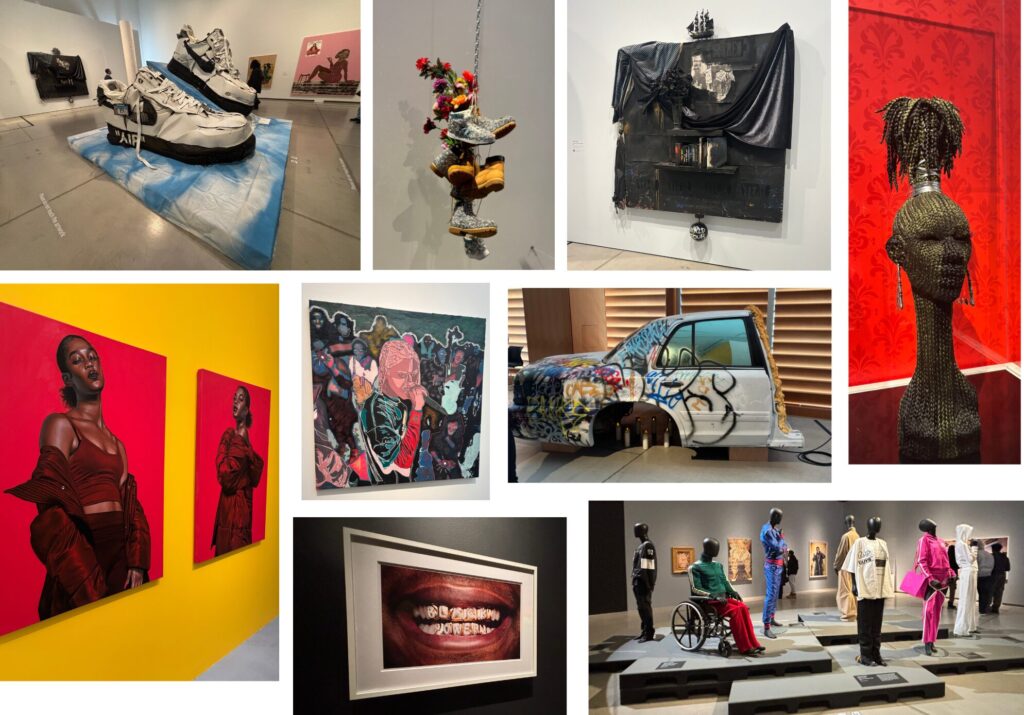
Kalmplex, Zanele Muholi, Gelatin Silver Print, 2008
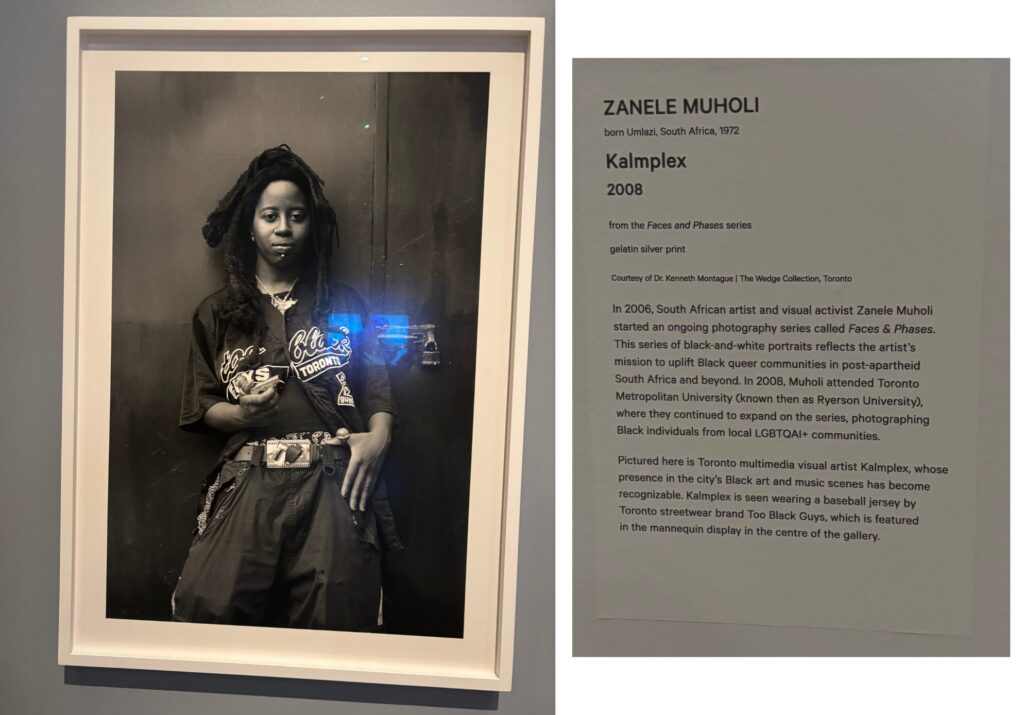
Kalmplex by Zanele Muholi was one of my favourite pieces in The Culture exhibit at the AGO. The photograph of visual artist Kalmplex is very well done. I enjoy the framing, the use of blacks and whites, and how natural it feels. Muholi did an excellent job of capturing Kalmplex in a natural position; it feels as if they’re just standing however they’re comfortable, and Muholi captured that, giving the piece a certain authenticity I wouldn’t have felt if it was posed differently. The silver print and the use of blacks and whites in this photograph increased the experience of viewing this piece for me, I could look at all of the intricate shapes and forms of Kalmplex’s outfit. I also picked out this piece due to my interest in 2SLGBTQIA+ artists and individuals, which Muholi is, and highlighting in the Faces and Phases Series. Recognizing my privilege as a White queer artist, I actively seek out Black queer artists and their works to uplift, especially since the at art world itself is so heavily whitewashed – so, finding the work of a Black queer artist depicting another queer artist at The Culture exhibit gave me serveral great artists to look at. It’s important to recognize the impact of Black individuals and artists on the queer community, after all it wouldn’t be what it is today without the help of Black transgender women. So much of queer language and phrases too, have stemmed from AAVE, mostly from Black drag queens and trans women. Overall, I enjoyed this piece and the look it gave me into Black queer culture, fashion and the importance of Black culture and how it’s interwoven with queer culture.
Don’t Talk To Me About No Significance Of Art, SHIRT, Inkjet on Canvas, 2021
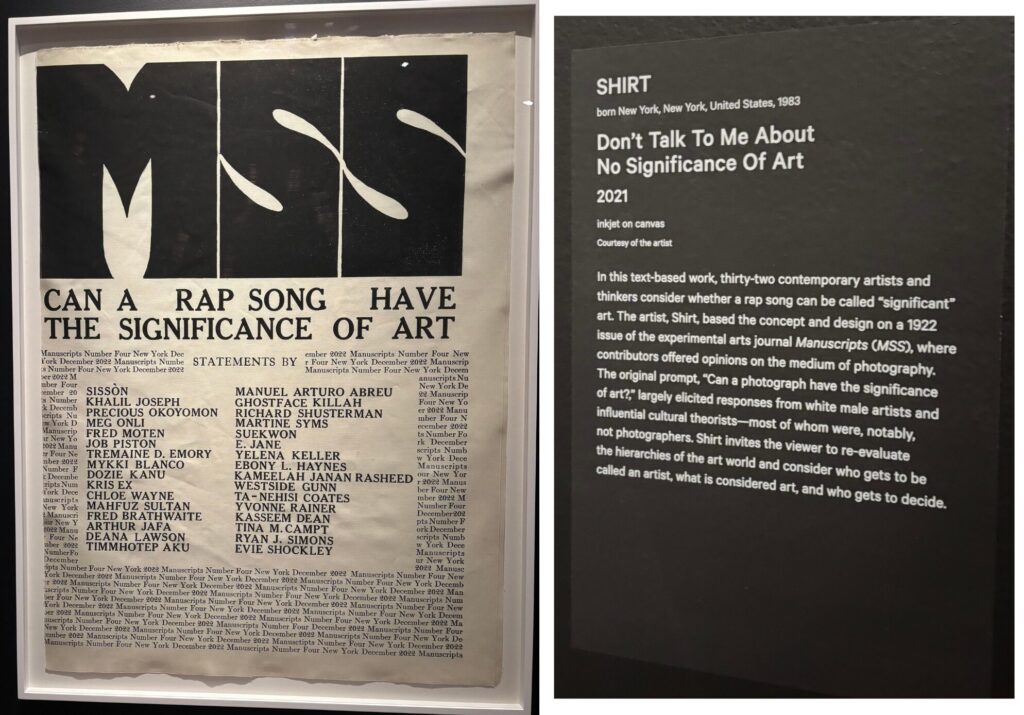
This piece first stuck out to me at first due to its use of text as art, which we learned about this semester. This piece poses a very important question, interwoven with the deep colonial ties in the art world, begging us to consider what can be considered art: “Can a rap song have the significance of art?” A rap song is indeed art, but those who do not consider it art should consider the rules of what we consider art. The notions and rules of who can be an artist and what art is are deeply rooted in racism, elitism, and colonialism, so to answer the question posed by SHIRT and the artist, we must remove any biases art has historically presented. This piece and what it represents are powerful, given just the medium of text. Seeing this piece and questioning a rap song as art also allowed me to look at some of the pieces in the exhibit in a way I had not before. I feel this piece intertwines with my artistic practice because I also enjoy challenging the notions of what art is, especially as a queer disabled artist whose communities have been often excluded from the artistic narrative. Overall, I enjoy this piece, the simplicity of the text art itself and the important question it has me consider.
Field Trip – The AGG
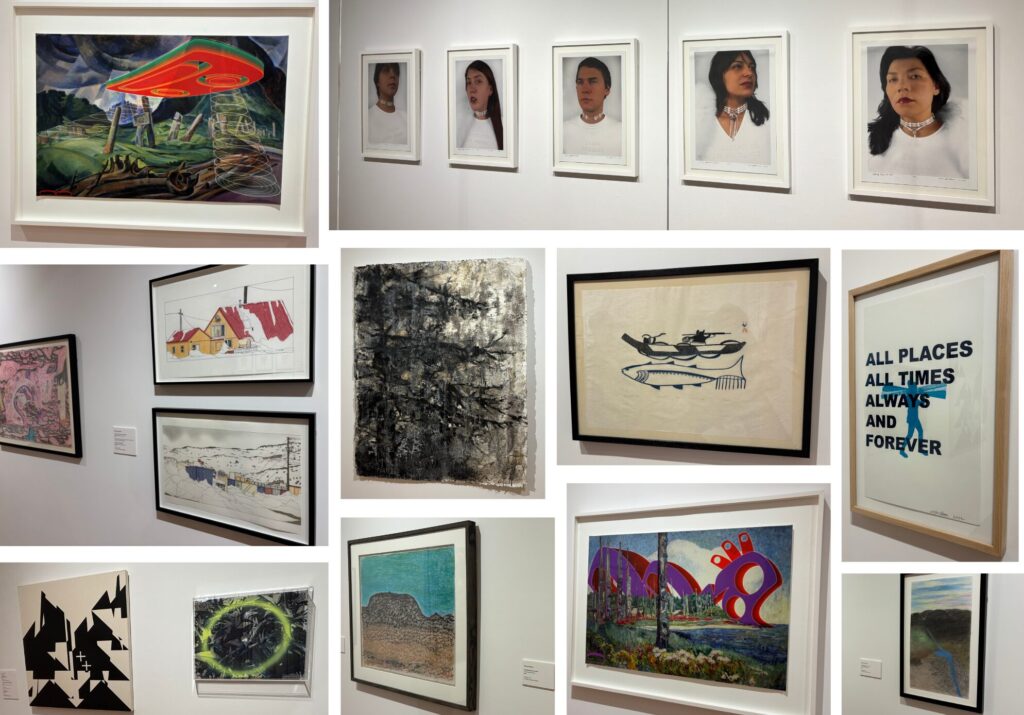
Making a b-line to HaidaBucks, Salmonberry Frap #ftw #starbucksfail #lol, Digital Intervention, 2016
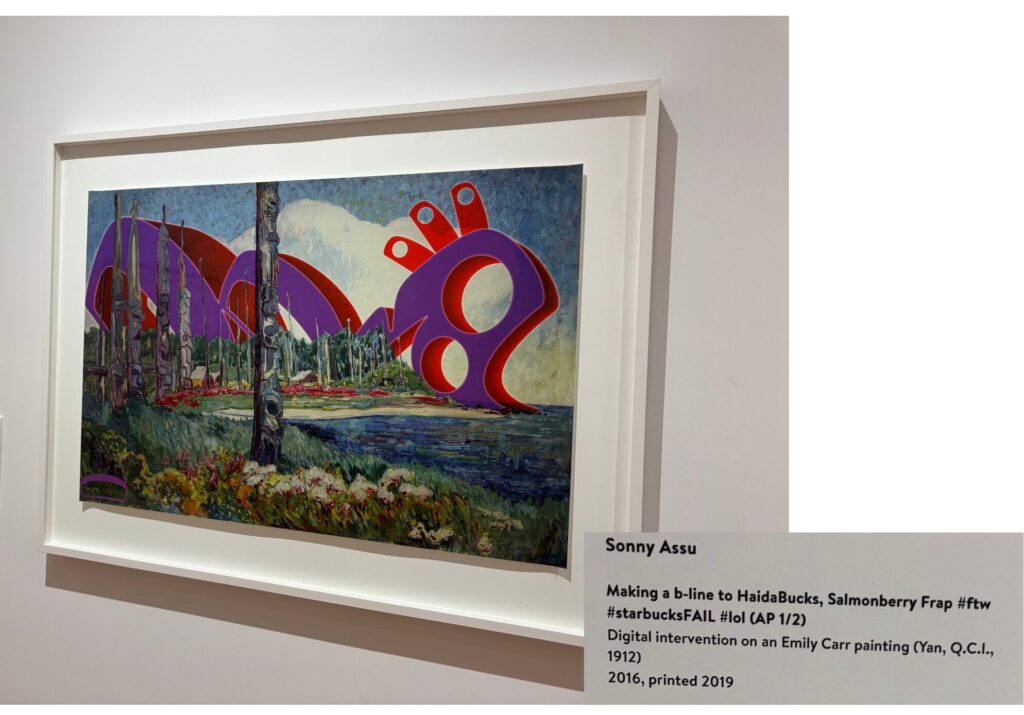
Making a b-line to HaidaBucks, Salmonberry Frap #ftw #starbucksfail #lol is a digital intervention print by Sonny Assu on a painting by Emily Carr. This piece first drew me in due to its vibrant use of colour – especially the large shape added in digitally by Assu. The shape looks out of place but it fits the painting so well. Through this series of works, Assu takes paintings by Indigenous artists or inspired by Indigenous art (Like Emily Carr’s works) and transforms them by altering them digitally, creating a blend of science fiction and traditional art, a perfect cultural hybrid. Through this, Assu injects his narratives into the piece, challenging how the viewer thinks of traditional landscape paintings. I really enjoy artworks that add things on top of preexisting artworks and have even explored that idea in my artistic practices, hence why I was so drawn to this painting. This makes me want to go even further in playing with the idea of adding or removing from already existing artworks to add my meaning to them.
https://www.artistrunwebsite.com/inspiration/1743/Cultural+Hybrids%3A+Art+by+Sonny+Assu
Cyborg Hybrids, a series by KC Adams, Digital Print, 2005
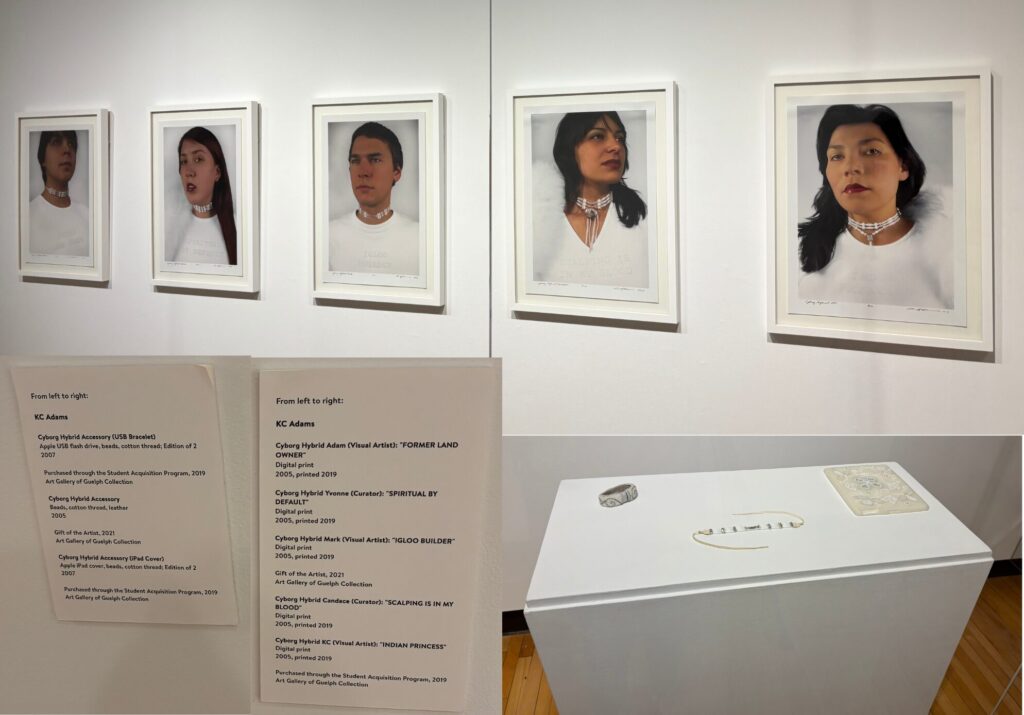
Cyborg Hybrids is a series of photos by Indigenous artist KC Adams. Adams herself explores technology in relation to her Indigenous identity, which is exactly what this series aims to do. The AGG exhibition of the series not only had the photos but also the accessories worn by the models in the photos. Adams wanted to create a mixing of two cultures, including Euro-Indigenous artists as her models. Each of the models dons a shirt with a humorous phrase on it, like “FORMER LAND OWNER” or “INDIAN PRINCESS,” all of which add a commentary to certain aspects of Indigenous culture, stereotypes, and humour. They each post stoically, framed in a way that mocks the photography of Indigenous individuals in the 19th and 20th centuries. She also digitally altered them to make the figures appear like they are in a fancy magazine. Per Donna Harroway’s Cyborg Manifesto, Adams views a cyborg as “a creature in a technological, post-gender world free of traditional western stereotypes towards race and gender” (KC Adams) and implores the artist to view this work through that lens. I was first drawn to this series for the striking way the photos are framed and how I felt as if I was being watched by each of the models with their stoic gazes. As I looked into the piece further through Adams’ artist statement, I found myself falling in love with the notion of the Cyborg. Our world nowadays is so binary and has Western stereotypes heavily embedded in every fabric of our society. This series allows me to think of a world beyond all of that, a marriage of culture and technology, transcending all Western stereotypes. As a nonbinary person, I like to explore the notions of breaking free of stereotypes towards gender in my art, hence my love for this completely different perspective of a practice I already engage in. I wish to explore more of her works because I find the concept of technology and its relation to cultural identity fascinating as we move to a more technically advanced world!
https://www.kcadams.net/art/photography/Hybrids/hybridmain.html
MFA Open Studios
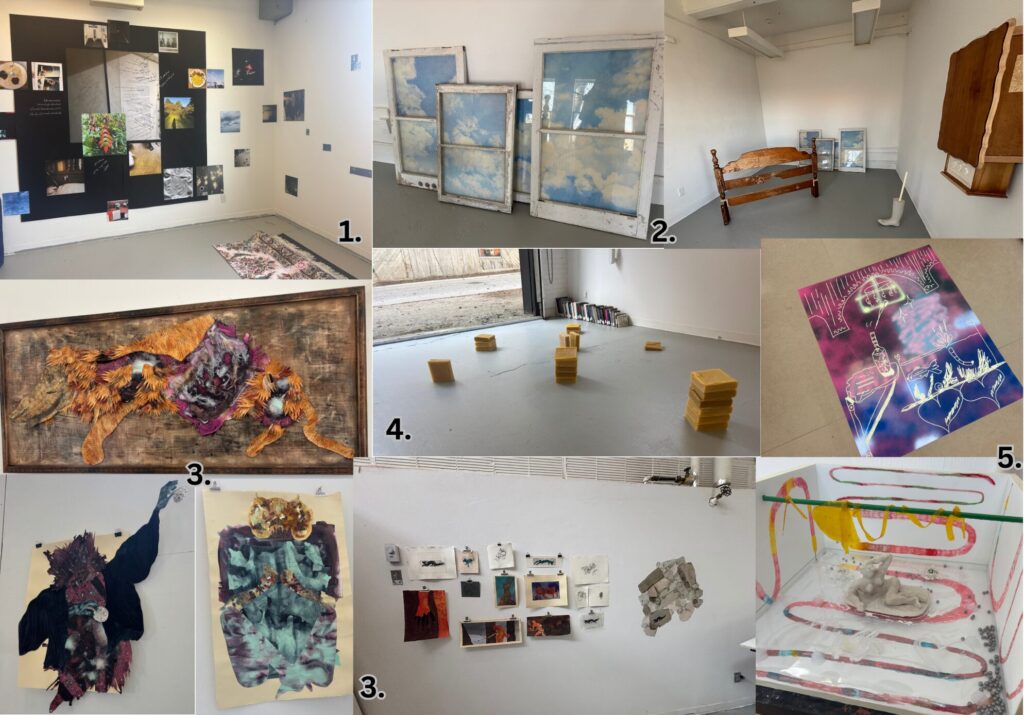
Visiting the MFA studios was very enjoyable for me, it opened up new possibilities for me that I had never quite experienced before. Going to university for art and building my artistic career, it’s easy to feel lost amongst it all. I’m in my third year and I feel like I still haven’t found my artistic niche, something I specialize in. It gives me a sense of imposter syndrome, like I don’t belong here with all of the other amazing artists. Seeing all of the different artistic practices in the open studios allowed me to realize just how broad the field of art is. There are so many ways to interpret and create art, I shouldn’t try to confine myself to a box. I enjoyed every studio I visited but I’ve detailed some of my favourites below.
Visiting Eunice Luk’s studio space, I was immediately enamoured by her works, especially the large bird’s nest and the spider sculptures. The use of natural and found materials was really beautiful and added a comfort to the space I didn’t expect. Upon entering the space and removing my shoes, Eunice immediately asked me to add a stick to her large bird’s nest sculpture. It’s shocking to think that every branch or twig was carefully selected by individuals like myself to create this labour of love.
I remember visiting Clea Christakos-Gee’s studio so vividly, the sun was shining so beautifully through the windows of Blackwood Hall, creating the most beautiful shapes as it refracted through all of Clea’s stained glass pieces. Clea and I spoke for a while, I looked through all of her collage materials. I have been enjoying collages in my practice, so seeing just how far you could take it widened my horizons. I especially liked going through her daily collage journals where she’d force herself to create one collage piece a day, It’s such a cool concept and what a way to not let artist block get the best of you! I don’t have any pictures because I was enjoying my conversation and exploration of Clea’s works too much!
Bridget Moser, My Crops are Dying but my Body Persists
Charlene Lau’s Review: https://www.artforum.com/events/bridget-moser-247483
Watching Moser’s My Crops are Dying but my Body Persists through the lens of Charlene Lau’s review, instead of my initial confusion and discomfort, I was able to more closely examine the themes Moser had intentionally left in the video. Moser makes us uncomfortable, both with her body language, prop humour and use of erotic imagery. All of the actions are rather absurd, yet Moser has her reasons.
The pairing of certain objects and scenes feels almost like a “GRWM (get ready with me)” video, a common trend on YouTube and TikTok1. She dons silk pyjamas, shows off a set of in Lau’s words, “consumerist, bourgeois junk—such as a rose-gold makeup mirror, white and gilt decorative ceramic objects, and a bottle of pink Himalayan salt—parodies displays of “haute” consumerist taste,” (ArtForum, Lau) the high-end face cream, the pasta hair braiding, and the emphasis on nails. I find both of these items very reminiscent of the influencer culture on YouTube and TikTok. It feels almost as if she is parodying the women, so obsessed with consumerism and how they look that they create these fake GRWM videos to idealize their life to their viewers. Like these videos, there’s an inherent loneliness in them, and I think Moser highlights that quite well. She craves intimacy, she craves touch, and she showcases that through her erotic movements or use of props. Another theme Moser highlights is that of white supremacy, white fragility, and white privilege. Historically and currently, in the Western world, whiteness is treated as an ideal, especially by white supremacists; they think everyone should want to be white. She shows herself embodying the white supremacy in a very unexpected and uncomfortable way, buttering a piece of white bread with an expensive moisturizer and sinking her teeth into it. It is through her dialogue that we gain the insight into her intentions to sink into white supremacy in the video, “This is where I come from, or anyways I think you can see the resemblance. We’re all a bit soft and not always digestible. We’re just used to certain comforts.” (ArtForum, Lau) She slowly becomes complacent to these thoughts, submitting to the notions and becoming complacent. As Lau puts it, “As if slowly awakening to white supremacy, the narrator begins to process it as a disease. Moser’s sardonic tone—with a hint of creepy innocence—exteriorizes these innermost thoughts, which turn into an earnest declaration of complicity.” (ArtForum, Lau) I think notions of white supremacy, fragility and privilege are very prevalent in influencer culture as well. These individuals, mostly white women, are very privileged for their place and following, most of them directly reaping the benefits of complicity in white supremacy – like Moser did in the performance. On the internet nowadays, we see so many women get famous simply because they’re pretty and white, yet when women of colour do the same thing, they don’t always get the same amount of views. There’s an inherent power white influencers have on platforms, and that’s highlighted in our society and Moser’s video.
Furthering my point of influencer culture, I also believe in influencer culture, there’s this need to have everything you do be constantly “aesthetically pleasing.” There are hundreds of “aesthetic” GRWM compilations all across the internet. People put on this perfect facade to present the perfect life to viewers. I believe Moser put in a lot of effort to make her sets aesthetically pleasing and clean, much like these influencer sets and rooms, directly parodying them. The influencer culture is so bad that there are even children as young as 4 trying to emulate this successful and ideal life. I will not include video references of the children to retain their privacy, but the number of impressed young girls wanting this idealized life supported by white supremacy is scary. I’ve found a video, however, from a creator I enjoy that delves into the topic of these young girls trying to copy these older, successful, white women influencers. 2
Examining her colour choices when going through this lens of white privilege and influencer culture, the colours chosen by Moser feel dainty and feminine – which is exactly how these influencers want to appear. In the video I’ve linked below 3 of a GRWM Tiktok compilation, almost every influencer dons white, pink, and dainty colours as worn by Moser.
In the final part of the video, Moser fully embraces all aspects of her white privilege, rubbing it in the viewers’ faces in a way. Like these influencers, her success and triumph are “built at the expense of others,” (ArtForum, Lau) as Lau puts it, and Moser is completely oblivious to it, much like these influencer figures. The video ends by telling those who have white privilege not to benefit from it completely obliviously but to actively take action against it, something many of these prominent white celebrities and influencers need to understand.
1:
2:
3:
Notes from watching before reading review:
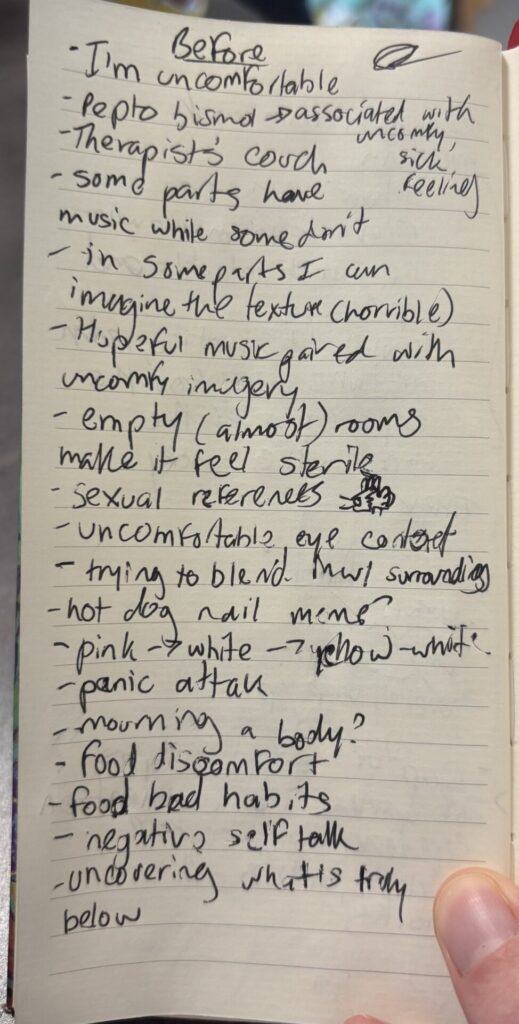
Notes from reading and watching after:
Watch the video again – in light of the commentary by Charlene Lau –
and comment on the ways Moser appropriates internet tropes, youtubers, pop culture references, and/or memes in this work.
- Enyaesque music, almost hopeful, feels very out of place with the uncomfortable imagery
- A parody of consumerist clutter with her choices of props
- A mix of oddly relaxing content and ASMR and erotic comedy
- notions of white supremacy and fragility with the bread that carries further into the video’s climax
- hot dog fingers meme
What are some of the things her colour choices, and/or her props and costumes remind you of? How do you experience the video physically?
- The colour choices almost remind me of a hospital, like in a hospital, pale colours are meant to bring calming energy, but to me it feels uncomfortable and sterile – this could connect to her themeing of the virus and COVID-19
What are some of the ideas Moser is playing with, including questions she is raising? What is the role of absurdity in her work? In your discussion of Moser’s work, you should quote the art forum review twice.
- Moser is playing with themes of intimacy, of discomfort and white privilage





